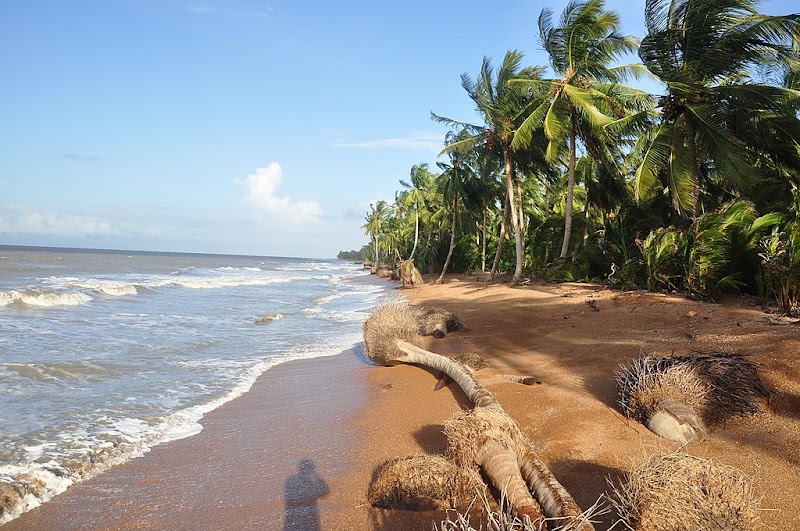
Experience the Barima-Waini Heritage Festival: Culture and Adventure in Mabaruma
The Barima-Waini Heritage Festival in Mabaruma brings culture and nature into perfect balance. Experience authentic indigenous traditions set against the backdrop of dense rainforest, with practical tips to navigate both the festivities and the rugged terrain.
Stay Hydrated Throughout the Festival
Tropical humidity and outdoor activities mean you’ll need constant hydration—carry a reusable water bottle and refill often.
Wear Durable, Non-Slip Footwear
Uneven forest paths around Mabaruma can become slippery, especially after rain; sturdy shoes with good grip protect your ankles and footing.
Plan Festival Visits by Daylight
Events and markets operate mostly during the day; early mornings and late afternoons are cooler and better for photography or exploring nature safely.
Respect Local Customs and Environment
Engage with indigenous traditions respectfully and avoid disturbing wildlife or littering to help preserve the area's cultural and natural heritage.
Experience the Barima-Waini Heritage Festival: Culture and Adventure in Mabaruma
The Barima-Waini Heritage Festival, held annually in the vibrant town of Mabaruma in Guyana’s Barima-Waini region, offers an immersive dive into the rich cultural heritage and natural beauty of this unique corner of South America. Far from the usual festival circuit, this event brings together indigenous communities, local artisans, and visitors eager to witness authentic traditions through drumming, dancing, crafts, and storytelling. The festival is more than a cultural display—it invites you to engage with a landscape fiercely its own, where the dense rainforest edges meet waterways that dare you to explore.
Mabaruma, a gateway to Barima-Waini, offers more than just festival excitement. The surrounding environment challenges and rewards with forest trails that wind through towering trees, each step offering the scent of moist earth and fresh leaves underfoot. Expect unpaved, sometimes uneven paths carved by the flowing rivers that compete for attention with the vibrant cultural events.
The festival itself is a practical adventure: schedule your visit between September and November for the most stable weather and the full swing of festivities. Daylight hours in this tropical region stretch long, allowing plenty of time to explore markets packed with handmade artifacts and sample local dishes rich with flavors both spicy and sweet.
Pragmatic adventurers should come prepared for tropical heat and humidity: lightweight, moisture-wicking clothing and reliable hydration systems are essential. Footwear with solid grip is a must; the forest paths can shift quickly after rains, becoming slick and testing your footing. Early morning or late afternoon sessions offer cooler temperatures with the soft glow of morning mist or sunset highlights perfect for photography.
The Barima-Waini Heritage Festival perfectly balances celebration and exploration. It’s a chance to connect with a dynamic, living culture and a landscape that demands respect. Each drumbeat and dance step echoes a story ruled by tradition and the wild pulse of the rainforest. For those drawn by both human stories and natural beauty, Mabaruma and its festival offer an invitation to witness something vibrant, deeply rooted, and fiercely alive.
Nearby Trips
All Adventures
Boat Charters
Water Activities
Adventures near Mabaruma, Barima-Waini
Discover the unique and memorable adventures that make Mabaruma, Barima-Waini special.
Frequently Asked Questions
What makes the Barima-Waini Heritage Festival unique compared to other festivals in Guyana?
This festival emphasizes indigenous culture from multiple communities within Barima-Waini, combining traditional dance, crafts, and storytelling in a remote rainforest setting rarely showcased elsewhere.
Are there any lesser-known spots to explore during the festival?
Yes, the nearby Mabaruma Forest Reserve has several scenic viewpoints overlooking the Barima River that many visitors overlook but offer quiet reflection and stunning natural panoramas.
Which wildlife can attendees expect to see near the festival areas?
Monitor lizards, toucans, and occasionally river otters are spotted along the trails and waterways. Early mornings provide the best chance for wildlife observation.
Is the festival family-friendly?
Absolutely. The event includes activities for all ages, and the surrounding nature offers safe and engaging experiences for kids with adequate supervision.
Does the festival focus on environmental conservation?
Yes, part of the festival’s mission is to promote eco-consciousness, encouraging visitors to respect the forest and waterways that sustain the indigenous communities.
What are the best times to take photos during the festival?
Early morning and late afternoon provide soft, natural light that enhances portraits and landscape shots, while evening cultural performances offer dynamic, vibrant scenes perfect for capturing movement and color.
Recommended Gear
Moisture-wicking Clothing
Helps you stay dry and comfortable through humid festival days and forest hikes.
Sturdy Hiking Shoes
Provides grip and stability on forest paths around Mabaruma that can quickly change from dry to slick.
Wide-brim Hat
Offers protection from the tropical sun during outdoor activities and daytime events.
Insect Repellent
Critical for avoiding bites when exploring forest areas during festival downtime.
Local Insights
Hidden Gems
- "The quiet lookout points along the Barima River, accessible by short hikes outside the main festival area."
- "Local craft workshops where artisans reveal traditional weaving and carving techniques."
Wildlife
- "Tropical birds such as the Guianan cock-of-the-rock and vibrant parrots."
- "Freshwater creatures frequenting the forest streams and river edges."
History
"Barima-Waini’s indigenous communities have preserved their customs for generations despite outside pressures; the festival is a vibrant celebration of resilience and identity."
